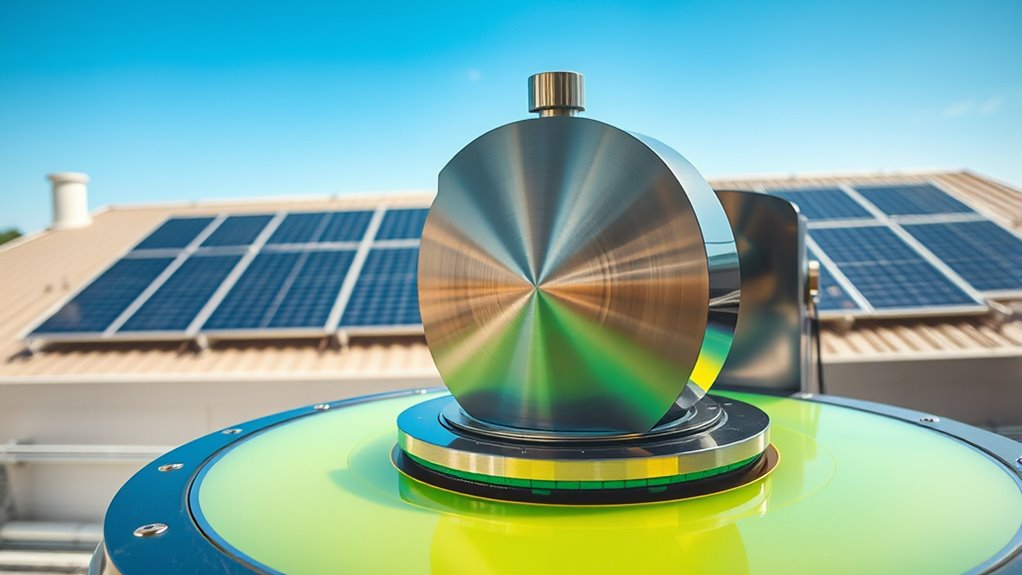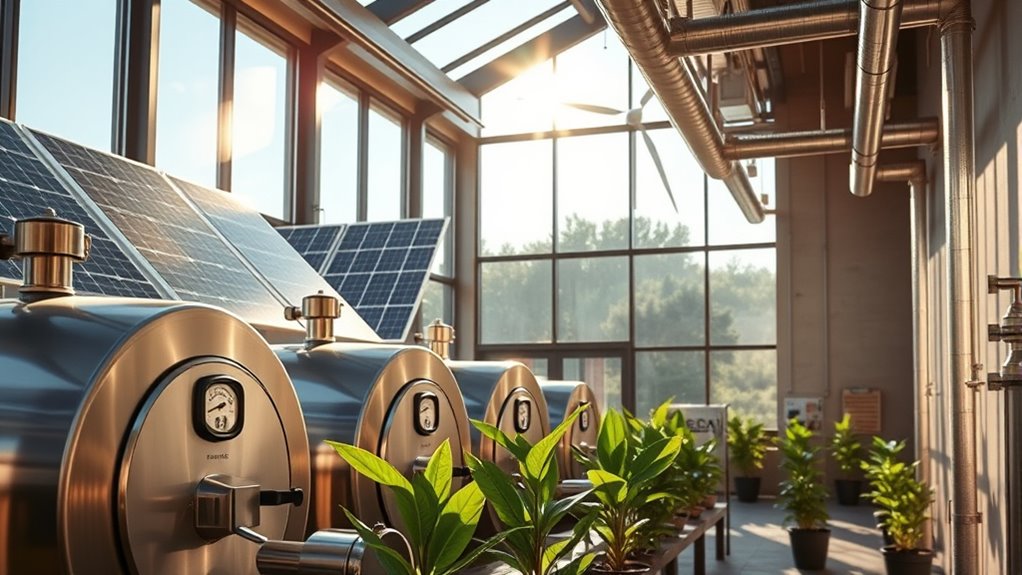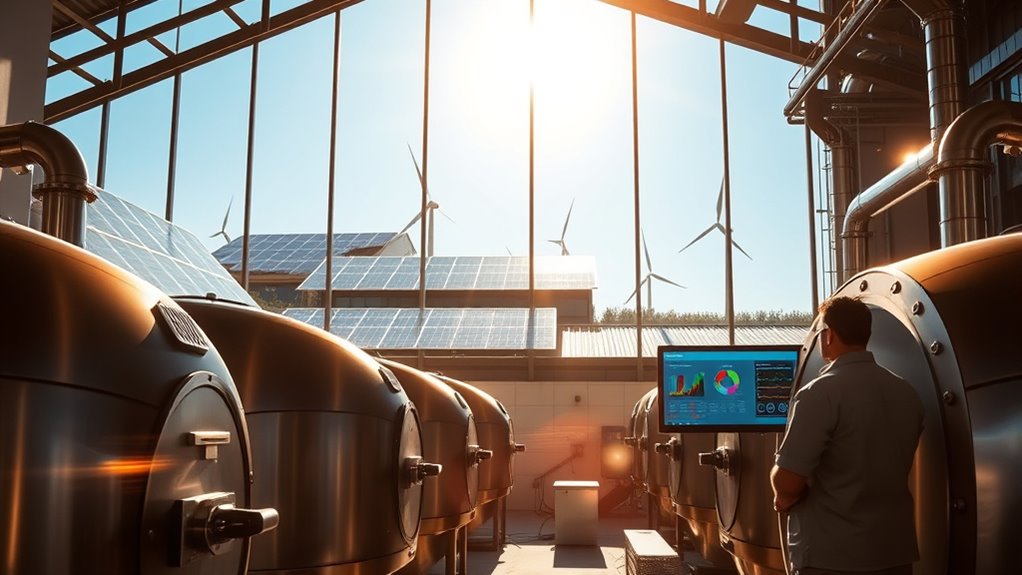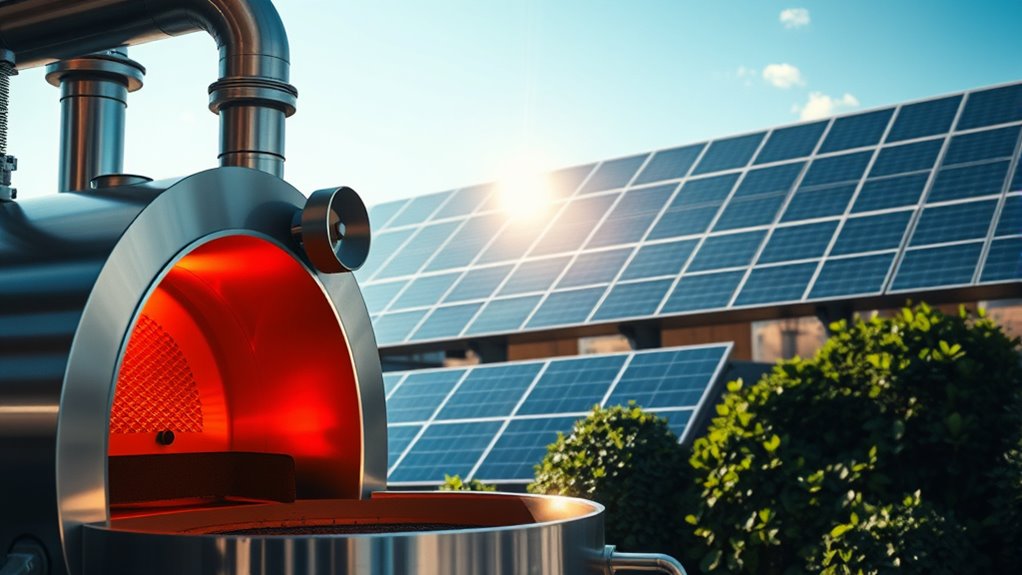Switching to renewable energy for drum roasting can markedly reduce your carbon footprint, but fully offsetting the high heat demands remains challenging due to costs, infrastructure, and technology limits. While biofuels, solar, and geothermal offer promising options, they often require substantial investments and system adjustments. You can move closer to carbon neutrality by adopting energy-efficient practices and integrating renewable sources. Keep exploring how innovative solutions are making this goal increasingly achievable in the near future.
Key Takeaways
- Renewable energy sources like biofuels, geothermal, and solar can supply heat for coffee roasting, reducing fossil fuel reliance.
- Achieving full carbon offset is challenging due to high energy demands and current technological limitations.
- Innovations such as waste heat recovery and energy management systems enhance the efficiency of renewable-powered roasting.
- Infrastructure costs and supply chain issues can hinder widespread adoption of renewable energy for drum heating.
- Combining multiple renewable options and systemic improvements increases the potential for meaningful carbon neutrality in roasting.
Understanding the Energy Demands of Coffee Roasting

Coffee roasting requires a significant amount of energy, primarily because of the high temperatures needed to transform green beans into aromatic, flavorful roasted coffee. An economic analysis shows that energy costs are a major part of production expenses, influencing profitability. You might also notice that consumer perception plays a role in your sustainability efforts; customers increasingly value eco-friendly practices and may favor brands committed to reducing their carbon footprint. The energy demand during roasting is intense and continuous, making it essential to evaluate energy sources carefully. As you consider renewable options, understanding the economic impact and how it aligns with consumer expectations becomes essential. This awareness helps you balance operational costs with the growing demand for environmentally responsible coffee. Additionally, integrating energy efficiency measures can significantly reduce overall consumption and support your sustainability goals.
Types of Renewable Energy Suitable for Roasting Operations

To make your roasting operation more sustainable, exploring renewable energy options can substantially reduce your carbon footprint and operational costs. Biofuel options, such as biodiesel or waste oil, can directly replace traditional fuels, offering a clean energy source for drum heating. Geothermal applications utilize underground heat to supply consistent, renewable energy, reducing reliance on fossil fuels. Wind and solar power can supplement energy needs, especially for auxiliary systems like lighting and cooling. Here’s a quick overview:
| Renewable Energy Type | Advantages | Suitable Applications |
|---|---|---|
| Biofuel options | Carbon-neutral, versatile | Drum heating, generators |
| Geothermal applications | Stable, low emissions | Heating systems, process heat |
| Solar power | Renewable, scalable | Powering auxiliary equipment |
Additionally, understanding the types of renewable energy suitable for roasting operations can help optimize your energy strategy for maximum efficiency and sustainability.
Technological Challenges in Achieving Carbon-Neutral Roasting

Achieving carbon-neutral roasting faces significant technological hurdles that can impede seamless integration of renewable energy sources. One major challenge is ensuring economic feasibility, as renewable systems often require high upfront investments and infrastructure modifications. Balancing supply chain complexities also poses difficulties; supply chain disruptions can limit access to reliable renewable energy supplies or necessary equipment. Additionally, existing roasting equipment is often designed for traditional heat sources, making upgrades costly and technically complex. Precise control of temperature and roasting conditions with renewable energy is another obstacle, since fluctuations in power supply can affect product quality. Overcoming these challenges requires innovative engineering solutions and strategic planning to make renewable-powered roasting both practical and sustainable without compromising efficiency or economic viability.
Innovations and Strategies for Integrating Renewable Power

To make your roasting process more sustainable, you can adopt solar-powered systems that harness renewable energy directly. Waste heat recovery methods also help maximize efficiency by recycling heat within your operations. Additionally, integrating with the grid through smart strategies guarantees a reliable and green power supply, reducing your carbon footprint. For instance, understanding support hours for various energy systems can ensure optimal operation and maintenance.
Solar-Powered Roasting Systems
Harnessing solar energy for roasting systems offers a promising path toward carbon neutrality by reducing reliance on fossil fuels. Solar-powered setups can be tailored to various scales, from small local roasters to large industrial facilities. These systems often incorporate innovative designs and storage solutions, guaranteeing continuous operation even when sunlight is scarce. Imagine this setup:
| Solar Panels | Storage Batteries |
|---|---|
| Direct sunlight | Power during the night |
| Flexibility in placement | Ensures consistent roast quality |
| Eco-friendly materials | Supports sustainable packaging and community engagement |
Additionally, integrating energy management systems can optimize the use of stored energy, enhancing efficiency and reliability.
Waste Heat Recovery Methods
Waste heat recovery has become a vital strategy for integrating renewable energy into roasting operations, allowing systems to reuse heat that would otherwise be wasted. You can capture excess heat from exhaust gases or hot surfaces and redirect it for other uses, boosting efficiency. Biomass boilers are a key innovation, converting organic waste into usable heat, reducing reliance on fossil fuels. Geothermal heating offers another effective method, tapping into the earth’s stable underground temperatures to provide consistent warmth. By incorporating these waste heat recovery techniques, you minimize energy loss and lower carbon emissions. Implementing world clock tools can help coordinate and optimize the timing of renewable energy systems across different locations. This approach not only enhances sustainability but also helps you optimize your energy systems, making renewable power sources more viable and cost-effective in your roasting process.
Grid Integration Strategies
Have you considered how innovative grid integration strategies can make renewable energy more reliable and efficient in roasting operations? Using battery storage, you can store excess energy generated during peak times and deploy it during low production periods, ensuring consistent heat without relying solely on the grid. This approach enhances grid stability by balancing supply and demand, reducing stress on the overall system. Smart grid technologies also enable real-time adjustments, optimizing energy flow and minimizing outages. Integrating renewable sources with advanced storage solutions helps you maintain continuous operation while reducing carbon emissions. Additionally, pilot shirts for men aviator can be customized with smart fabrics to further improve energy efficiency. These strategies make renewable energy a practical, dependable option for your roasting process, bridging the gap between intermittent supply and consistent heat needs.
Assessing the Environmental Impact and Feasibility

Evaluating the environmental impact and feasibility of carbon-neutral roasting involves examining both its potential benefits and the practical challenges involved. You need to contemplate how implementing renewable energy sources affects the overall carbon footprint of your roasting process. Sustainability metrics can help you measure improvements, such as reductions in greenhouse gas emissions and energy consumption. While switching to renewables can lower your environmental impact, you must also assess the reliability and scalability of these solutions. Costs, infrastructure requirements, and local energy grid stability play significant roles in feasibility. Additionally, understanding home improvement principles can inform the optimization of energy efficiency in your facility. Ultimately, you’ll want to balance environmental benefits with operational practicality, ensuring your efforts lead to genuine sustainability without compromising quality or efficiency.
Future Outlook: Can Full Offset Be Attained?

Achieving full carbon offset in roasting is an ambitious goal that hinges on advancements in renewable energy, innovative technologies, and systemic changes. While carbon offsetting is promising, it requires significant improvements in energy efficiency across operations. To reach complete offset potential, focus on:
- Scaling renewable energy sources, like solar or wind, to power roasting facilities fully.
- Developing smarter energy management systems that optimize usage and reduce waste.
- Investing in innovative roasting technologies that lower energy consumption without compromising quality.
- Incorporating energy-efficient practices throughout the entire roasting process to further reduce overall carbon emissions.
While full offset remains challenging today, steady progress in these areas suggests it’s possible in the future. Your commitment to embracing energy efficiency and renewable energy will be key in making carbon-neutral roasting a reality.
Frequently Asked Questions
What Are the Economic Implications of Switching to Renewable Energy for Roasting?
Switching to renewable energy involves a detailed cost analysis to understand long-term savings and upfront investments. You might face investment challenges, such as higher initial costs for equipment and infrastructure. However, over time, renewable energy can reduce operational expenses and carbon footprint. You need to weigh these factors carefully, considering both immediate costs and future economic benefits, to determine if the switch aligns with your business goals.
How Does Renewable Energy Impact Coffee Flavor and Roasting Quality?
You might wonder how renewable energy impacts coffee flavor and roasting quality. By using cleaner energy sources, you can enhance flavor preservation and achieve better roasting consistency, since renewable options often provide more stable heat. This reduces fluctuations that can compromise quality. Plus, sustainable energy supports a more controlled roasting process, ensuring you get the desired flavor profile, while also aligning with environmentally responsible practices.
Are There Industry Standards or Certifications for Carbon-Neutral Roasting Practices?
You should look into certification standards and industry benchmarks for carbon-neutral roasting practices. These standards, like those from the Carbon Trust or Fair Trade, guarantee you’re meeting verified environmental goals. They help you demonstrate your commitment to sustainability and guide you in implementing best practices. By adhering to recognized certification standards, you can confidently position your roasting process as environmentally responsible and align with industry benchmarks for carbon neutrality.
What Are the Potential Regulatory Hurdles for Implementing Renewable Energy in Roasting?
You might face regulatory hurdles when implementing renewable energy in roasting, like steering zoning restrictions that limit where solar panels or wind turbines can be installed. Additionally, government incentives for renewable energy projects can vary, making funding or tax benefits uncertain. These factors require you to plan carefully, ensuring compliance and maximizing available incentives, to successfully incorporate renewable energy into your roasting process.
How Can Small-Scale Roasters Feasibly Adopt Renewable Energy Solutions?
Imagine you’re a small roaster exploring solar integration to power your operation. You can install solar panels and pair them with energy storage systems to guarantee consistent heat during cloudy days or nights. This approach makes renewable energy feasible, reduces reliance on fossil fuels, and cuts costs long-term. By actively managing energy flow, you turn sustainability into a practical, achievable goal, even on a small scale.
Conclusion
So, next time you sip that perfectly roasted cup, imagine the drum spinning thanks to a tiny solar panel while wind turbines cheer on. Will renewable energy truly power every roast and keep the carbon ghosts at bay? Maybe. Or perhaps someday, your favorite brew will come with a side of wind farm bill, reminding us that even in the quest for zero emissions, a little humor — and plenty of energy — still fuels the fire.







